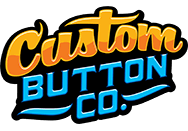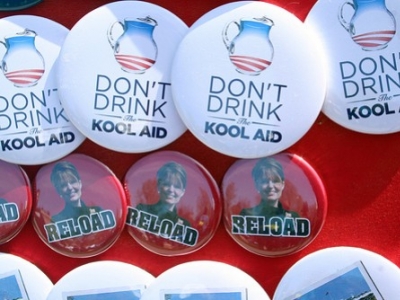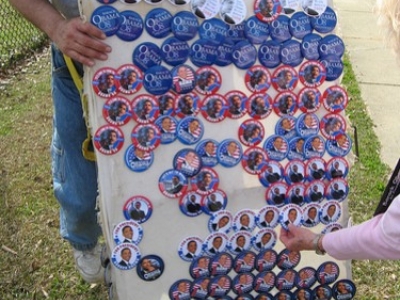A few attractive looking girls never hurt the cause.
You could just straight up ask, of course. It doesn't always work, but there's nothing wrong with trying.
For the rest of you timid and quiet types, there are always other sneaky ways of closing the sale and getting people to buy your stuff. Some of it will still involve talking though, so you might have to work on that aspect of your game a little. This is no longer the 8th grade school dance with girls on one wall and boys on the other. It's time to engage, connect and dominate your booth. It's like my grandma always said; you chat or you bat. I still don't know what that means. She was going senile.
Anyway, what you want to do is give people blackmail incentives to purchase your goods. Give them a reason to buy and if they still don't, they probably weren't a customer anyway. Just move on. Don't give too much thought to those who walk away.
So let's get down to bee's wax. Here are 9 awesome ways you can manipulate ask for the sale and make more pocket-green!
1. Offer A Discount
If your customer is talking you up but doesn't appear any closer to shelling out dough for something, it may be wise to offer them a hickey discount (you did allow for a bit of a margin on your merch, right?). It's human nature; a bargain is hard to pass up, and if it's something they really want to buy anyway, they'll probably walk away with your goods. Catch the impulse buyers early in the transaction.
2. Throw Something In For Free
People love free stuff. It's like those iTunes download cards they give away at Starbucks. Even when I know that there are too many steps to the download process, I always pick them up and take them home anyway. Stupid cards. If I wasn't so addicted to their black tea lemonade, I wouldn't frequent Starbucks so often.
If a customer is about to walk away but they seem interested in something specific, throw something else in for free and see what happens. You might have a bite.
3. Offer Another Perk
People get pretty creative with their Kickstarter campaigns, don't they? If you're looking to close the deal, you could offer a free painting lesson, a tour of your studio, or a house concert. You could even offer to be their dinner date. Just don't suggest the dinner date idea to someone creepy. That could be risky. And scary.
If it's a big ticket item you're selling, just throw in a bunch of cheap affordable swag (buttons, coasters, stickers, etc.) to seal the deal.
4. Offer To Sign The Merchandise
If you're an author, designer, musician or other visible entity of your business, you could offer to sign whatever item the customer seems interested in. Sometimes, over the long haul, this does increase the value of the goods purchased (hello, eBay). People like stuff that's custom tailored to them specifically.
5. Suggest An Alternative
A wise man once said you have eight ears and one mouth, so use them proportionately. Wait... two ears. Sorry, wrong planet.
Look, sometimes we're just not great listeners and when we think a prospect wants one thing, they might really want another. Or maybe they haven't decided yet. If something just isn't right, take your attention away from one item and put it on another. See if they go for it.
6. Allow Customers to Name Their Own Price
Not only is allowing your customers to name their own price an effective tactic, many have found that they are no worse off financially for it. Some will give you $20 for a $10 item, some will give you the asking price, some will give you less, and some will try to pay you with goats. Nothing against goats, but money is probably a better trade. Unless you've always wanted a goat. I won't judge.
7. Donate A Percentage Of Your Profits To Charitable Causes
You might already be giving a percentage of your merch income to charity or other causes, but unless your buyers are aware of it, there isn't as much of a point to it. You're not exploiting using the situation to your advantage. You could always have a sign or a pamphlet that talks about the causes you give to and why you're passionate about them. You could tell people upfront as they approach your table.
People are in to this kind of stuff. They want to support a good cause if they know that it actually furthers their agenda helps humanity.
8. Hand Them The Item
Here's a bit of a sneaky sales tactic. If your customer seems interested in a particular piece, take their hand and put the item in their palm. It is one thing to look, but it's quite another to touch and feel. Your prospect just might end up wanting to hold onto what is already in their hand. If so, score. If not, at least you tried. Just don't drop a heavy item on their hand. It might make for a funny story, but it will probably be a deal-breaker.
9. Share A Story
In case you hadn't noticed, people like stories. A lot. Share a crazy story about someone who bought your swag and somehow wound up on a boat three days later with a unicorn tattoo and legally married to a Jamaican (warning: product benefits might include a tattoo and marriage to a Jamaican).
Just in case there's any confusion, I'm not suggesting that you make up stories. However, you are allowed to take some creative liberties and exaggerate a little.
Convincing Strategies for Merchandise Sales
Understanding how to convince potential customers to buy your product is crucial in sales, for sure. It involves keenly listening to customers to understand their needs and tailoring your sales pitches to highlight how your product meets these needs and helps with a positive decision about buying.
Effective persuasion also includes showcasing the benefits and dozens of features of your merchandise through storytelling, making it more than just an item, but a solution. Interactive demonstrations and personalized consultations can also enhance the customer experience, creating a deeper connection beyond the transaction.
Using clear and positive language is vital, too. Phrases like "imagine how this will improve..." or "you'll love how this enhances..." are often more convincing than simply listing features.
Incorporating these strategies can effectively help with such an issue as how to persuade someone to buy something, increasing the likelihood of a purchase of a decision maker. Remember, how to encourage someone to buy your product often depends on how well you connect with them and address their needs.
Showcasing Your Merchandise's Unique Appeal
When it comes to how to get customer to buy your product, highlighting its uniqueness is key. Differentiate your merchandise by focusing on what sets it apart. This could be a unique design, innovative functionality, or even an interesting backstory. Use these unique aspects as a focal point in your marketing and sales conversations.
Share the inspiration behind your product or any unique features that make it special. Customers are often drawn to products with a story they can relate to or feel a part of. So, do not forget the benefit of emotion.
Visuals also play a critical role. Ensure that your merchandise is presented in an appealing way, whether it's through high-quality images, engaging displays, content marketing, social media posts, or creative packaging. A visually appealing product can often speak louder than words.
Tips for Creating a Sense of Urgency in Sales
Creating a sense of urgency can be a powerful tactic in persuading customers to make a purchase. To how to persuade someone to buy something, emphasize the time-sensitive nature of the offer. This could be through limited-time discounts, exclusive deals for early birds, or highlighting the scarcity of the product. Countdown timers on websites or signs indicating limited stock can effectively convey urgency.
Another strategy is to create exclusive, time-bound offers for special occasions or events. This not only creates urgency but also makes the purchase feel more special and tailored.
In employing these tactics, it's essential to strike a balance. The urgency should feel genuine and not pushy. The goal is to nudge the customer towards a purchase decision by making them feel that delaying could mean missing out on a great deal or unique opportunity.
When it comes to a quick question like ‘How do you ask someone to buy something?’, it usually involves creating a context where the purchase decision feels urgent and necessary because a well-crafted sense of urgency can turn a hesitant browser into a committed buyer.
The Power of Special Deals in Boosting Sales
Special deals can be a game-changer in increasing merchandise sales. To understand how to ask someone to buy your product, consider the allure of an attractive offer. Discounts, bundled deals, or limited-time promotions can make your merchandise more appealing and can act as a significant incentive for customers to make a purchase.
So, how to ask to buy something? One effective approach is to offer a discount on the next purchase. This not only encourages the current sale but also promotes future engagement with your brand. Another strategy could be bundling products together at a reduced total cost, providing perceived added value to the customer.
Seasonal or holiday sales are also powerful in driving purchases. These deals, tied to a specific time of year, can create a sense of urgency and exclusivity. It's important, however, to ensure that these offers are well-timed and relevant to your target audience.
Using Social Proof to Boost Merchandise Sales
Social proof significantly influences merchandise purchases. Demonstrating how to ask someone to buy something from you becomes more effective when you leverage social proof. This includes showcasing customer testimonials, user reviews, or highlighting your product's popularity.
Incorporating positive reviews and testimonials on your website or in your store can sway potential buyers. People often rely on others' experiences and opinions when deciding, especially in competitive markets.
Media mentions or endorsements from recognizable personalities can also enhance your product's credibility and appeal. Showcasing such endorsements boosts confidence in your merchandise.
Social media engagement plays a great role too. Displaying how customers enjoy and use your product on platforms like Instagram or Facebook, through blog posts, business articles or even when you have eye contact with them can generate excitement and prompt others to buy.
Key Factors in Ensuring Quality and Value in Merchandise
When considering how to ask someone to buy something, the product itself must uphold a standard of excellence that justifies the ask. Quality and value are not just features; they are promises to your customers.
One key factor is the use of high-quality materials. This not only improves the longevity and performance of your product but also enhances customer perception of its value. Be transparent about the materials and processes used, as this can be a major selling point for discerning buyers.
Another aspect is consistent quality control. Regular checks and balances throughout the production process ensure that every item meets your high standards. This attention to detail can be a significant differentiator in a crowded market.
Finally, excellent customer service adds to the perceived value of your merchandise. Providing responsive, helpful, and friendly service can turn a one-time buyer into a loyal customer. It’s about creating an overall experience that resonates with buyers long after the purchase.
When figuring out how to ask someone to buy something, the quality and value of your merchandise should speak for themselves. By focusing on these key factors, you can build trust and credibility with your customers, making the decision to buy an easy one.
Can you think of other creative ways to close the sale? Try me! Leave a comment and give us all your secrets!
Cover image by NightRStar via photopin, cc license.

 Making Buttons for Your Favorite Fandom
Making Buttons for Your Favorite Fandom
 5 Tips For Great Campaign Buttons
5 Tips For Great Campaign Buttons
 How to make campaign buttons:10 Essentials for 2024
How to make campaign buttons:10 Essentials for 2024
 How Colors Can Change the Mood of Your Custom Buttons
How Colors Can Change the Mood of Your Custom Buttons




